Graphic:
Excerpt:
In the book Aging in the Right Place from 2015, author Stephen Golant provides a number of reasons why that “right place” might be the longtime family home:
•The advantages of a familiar neighborhood: the individual knows the shops and services and can navigate the area well even after physical or cognitive decline.
•The advantages of a familiar home: spatial competence (finding your way when the power goes out, navigating steps out of familiarity)
•Preserving familiar relationships – friendships and service providers.
•The attachment to possessions and pets is not disrupted (e.g., vs. moving to no-pets home); the home not only contains memories of the past but also reminders of past successes.
•The home affirms one’s self-worth; one fears (whether rightly or wrongly) that others will consider the person a “retirement failure” upon moving.
….
“The bitter truth is that an older person can succeed at remaining in her or his own home and still live a life as empty and difficult as that experienced by nursing home residents. Feeling compelled to stay in one’s home, no matter what, can result in dwindling choices and mounting levels of loneliness, helplessness, and boredom.”
This is a stark message. But here’s an even more discouraging problem: in my research on the issue, I encountered one repeated refrain. There is no solid scholarly research which asks the question: “which choice is the better one, in terms of future quality of life, to stay or to move?” It’s not an easy question, to be sure: simply looking at the quality of life of the elderly and comparing those who live in single-family homes vs. various kinds of “elder-friendly” housing would not adequately distinguish between those who moved due to some sort of health problem and those who moved with the aim of preventing future health problems, for example.
Publication Date: 5 June 2022
Author(s): Elizabeth Bauer
Publication Site: Forbes


